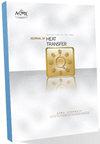亚连续晶格玻尔兹曼模型模拟纳米流体在振荡磁场中的自然对流流动
IF 2.8
4区 工程技术
Q2 ENGINEERING, MECHANICAL
引用次数: 0
摘要
摘要采用次连续无维晶格玻尔兹曼模型模拟了纳米流体在振荡磁场中的自然对流流动。建立了考虑纳米颗粒浓度和两个Knudsen数耦合效应的有效电导率模型。在哈特曼数(0.1≤Haf,L≤600)和瑞利数(103≤Raf,L≤107)的宽范围内,研究了磁场方向、频率和强度幅值的影响。为了获得更高的周期平均努塞尔数Nu¯f,L,最优磁方向与重力方向相同或相反。在Raf,L<104的低瑞利数区,磁频率f ~ B的影响可以忽略不计。在对流占优状态下,Nu¯f,L随Raf增大,L按Raf的顺序增大,在垂直和水平磁方向上分别为L0.48和L0.45,且Nu¯f,L的最大值出现在各磁方向的最优磁频率f ~ B=1/5cs*MaL(L/UL)处。当Raf,L > 106时,瞬态壁面平均努塞尔数Nu¯f,L随Haf,L的增大而增大,但周期平均努塞尔数Nu¯f,L随Haf,L的增大而从9.35减小到1.42,在5≤Haf,L≤500的瞬态区。与此同时,瞬态流线和等温线表明,传热模式随着Haf,L的增加而从对流为主转变为传导为主。本文章由计算机程序翻译,如有差异,请以英文原文为准。
Natural Convective Nanofluid Flows Immersed in Oscillating Magnetic Fields Simulated by a Sub-Continuous Lattice Boltzmann Model
Abstract Natural convective nanofluid flows immersed in oscillating magnetic fields are simulated with a sub-continuous nondimensional lattice Boltzmann model. The effective electrical conductivity model is built including coupled effects of nanoparticle concentrations and two Knudsen numbers. Effects of directions, frequencies, and strength amplitudes of the magnetic fields are studied in wide ranges of Hartmann numbers (0.1≤Haf,L≤600) and Rayleigh numbers (103≤Raf,L≤107). To achieve higher values of cycle averaged Nusselt numbers Nu¯̂f,L, optimal magnetic directions are along or opposite from the gravity directions. Effects of the magnetic frequency f˜B are negligible, in the conduction dominating lower Rayleigh number regime of Raf,L<104. In the convection dominating regime, Nu¯̂f,L increase with Raf,L in orders of Raf,L0.48 and Raf,L0.45 for vertical and horizontal magnetic directions, respectively, and maximum values of Nu¯̂f,L appear at the optimal magnetic frequency of f˜B=1/5cs*MaL(L/UL) for all magnetic directions. With Raf,L as high as 106, the oscillating amplitudes of the transient wall mean Nusselt numbers Nu¯f,L increase with increasing Haf,L, but the cycle averaged Nusselt numbers Nu¯̂f,L decrease from 9.35 to 1.42 with increasing Haf,L in the transient regime of 5≤Haf,L≤500. Meanwhile, heat transfer patterns transit back from convection to conduction dominating patterns with increasing Haf,L, as illustrated by transient streamlines and isotherms.
求助全文
通过发布文献求助,成功后即可免费获取论文全文。
去求助
来源期刊
自引率
0.00%
发文量
182
审稿时长
4.7 months
期刊介绍:
Topical areas including, but not limited to: Biological heat and mass transfer; Combustion and reactive flows; Conduction; Electronic and photonic cooling; Evaporation, boiling, and condensation; Experimental techniques; Forced convection; Heat exchanger fundamentals; Heat transfer enhancement; Combined heat and mass transfer; Heat transfer in manufacturing; Jets, wakes, and impingement cooling; Melting and solidification; Microscale and nanoscale heat and mass transfer; Natural and mixed convection; Porous media; Radiative heat transfer; Thermal systems; Two-phase flow and heat transfer. Such topical areas may be seen in: Aerospace; The environment; Gas turbines; Biotechnology; Electronic and photonic processes and equipment; Energy systems, Fire and combustion, heat pipes, manufacturing and materials processing, low temperature and arctic region heat transfer; Refrigeration and air conditioning; Homeland security systems; Multi-phase processes; Microscale and nanoscale devices and processes.

 求助内容:
求助内容: 应助结果提醒方式:
应助结果提醒方式:


